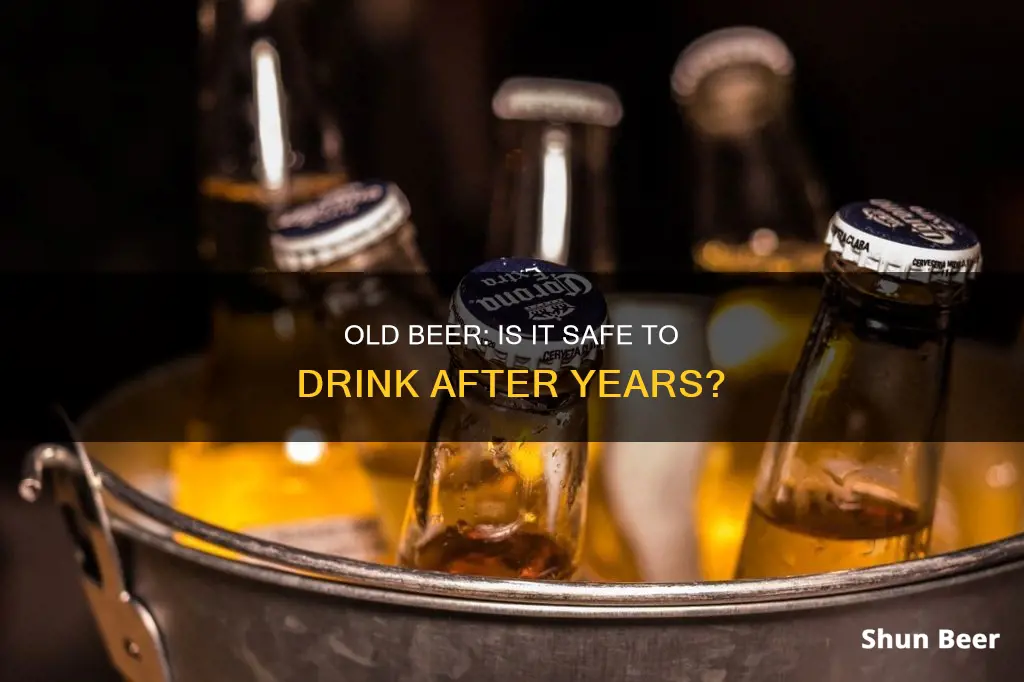
It's generally safe to drink beer past its expiration date, even if it's three years old. However, the taste and quality of the beer will likely have deteriorated over time, and it may taste flat or stale. Beer is similar to wine in that it continues to age and change after bottling, but unlike wine, its flavour usually worsens rather than improves.
| Characteristics | Values |
|---|---|
| Is it safe to drink? | Yes, but it may not taste good. |
| Will it taste good? | Probably not. It may taste stale, flat, or sweet. |
| Does packaging affect taste? | Yes, beer in cans is more likely to taste fresh than beer in bottles. |
| Does temperature affect taste? | Yes, keeping beer refrigerated slows down the oxidation process and keeps the flavour and aroma for longer. |
| Does light affect taste? | Yes, the darker the storage conditions, the better the flavour will survive. |
| Does alcohol content affect taste? | Yes, the more alcohol is present, the longer it will last. |
What You'll Learn

Is 3-year-old beer safe to drink?
It is generally safe to drink 3-year-old beer, but there are a few things to keep in mind. Firstly, beer does expire, but it doesn't become unsafe to drink—it just starts to taste unappealing or flat. The taste of the beer will depend on factors such as the type of beer, packaging, and storage conditions.
In terms of packaging, cans are better than glass bottles at preserving the flavour of beer. This is because cans are airtight, whereas glass bottles allow oxygen inside, which can interact with the compounds that give the beer its flavour and aroma. Additionally, light affects flavour, so beer stored in clear glass bottles may not last as long as beer bottled in brown glass.
The type of beer also makes a difference. Standard strength beers, such as pale ales, IPAs, and lagers, tend to stay fresh for 6 months to 2 years after brewing. Stronger beers, like porters or imperial stouts, can maintain their flavour for 5 to 10 years.
Storage conditions are crucial, too. Beer should be stored upright in a cool, dark place, at a consistent temperature. Refrigeration is ideal, as it slows down the oxidation process, but for some beers, such as wild or sour ales, refrigeration can be too cold for the flavour to develop properly.
In summary, 3-year-old beer is generally safe to drink, but the flavour and quality may have deteriorated, depending on the type of beer, packaging, and storage conditions.
Exploring Beer Drinking Rules in National Parks
You may want to see also

Will it taste good?
It's unlikely that 3-year-old beer will taste good. Beer doesn't typically "expire" in the sense of becoming unsafe to drink, but it does start to taste unappealing or flat. The flavour of beer deteriorates over time, especially if the beer is exposed to light or oxygen, or if it is subjected to temperature fluctuations. The higher the alcohol content, the less impact ageing will have on the beer, but even beers with high alcohol content will not taste as good after three years.
The impact of ageing on beer depends on the type of beer. Light-bodied, low-ABV beers tend to lose their flavour more quickly than darker, high-ABV beers. A 4% American Lager will start to lose its flavour within a year, whereas a 10% ABV Imperial Stout can handle several years of ageing.
The way the beer is packaged also makes a difference. Canned beer will maintain its flavour better than bottled beer, because cans prevent light from entering and maintain an airtight seal. Beer bottles, especially clear or green bottles, allow UV light to reach the beer, causing it to "skunk". Beer caps can also break down over time, allowing air into the bottle.
Temperature fluctuations can also impact the flavour of beer. It's best to keep beer at a consistent temperature of under 50 degrees, ideally in a refrigerator.
Emergency Contraception and Alcohol: Is Plan B Effective?
You may want to see also

How to store beer to prolong its shelf life
Beer is an organic substance, and improper storage can cause it to spoil. However, if stored correctly, beer can be safely consumed past its expiration date, although its taste may be affected.
Choose the Right Container
Canned beer offers better protection from light exposure and oxygen than bottled beer, making it a superior choice for packaged beer. Dark bottles, such as amber or brown bottles, are better than clear or green bottles as they block out ultraviolet rays that can cause spoilage.
Store Beer Upright
Storing beer upright limits the amount of beer exposed to oxygen, slowing the rate of oxidation and preserving carbonation levels. This is especially important for bottled beer, as lying the bottle on its side can increase the risk of air leaks.
Keep Beer in a Cool, Dark Place
Beer should be stored in a cool, dry, and dark place, away from direct sunlight and heat sources. The optimal temperature for storing beer is between 45 and 55 degrees Fahrenheit (7-13°C). Refrigeration can extend the shelf life of beer up to two years, but it is not recommended for beers meant to be cellared or aged, as it can slow the development of flavour.
Consume Beer Within Recommended Time Frames
Beer is best consumed within three to six months of its expiration date for optimal taste and quality. However, if stored properly, beer can last for six to nine months past the expiration date, and even longer if refrigerated.
Other Considerations
- Avoid temperature fluctuations, as heat can accelerate the chemical breakdown of beer and affect its flavour.
- Avoid exposing beer to bright light, as this can cause "skunking" or "light strike," resulting in an unpleasant sulphur off-flavour.
- Avoid high humidity levels when storing beer, as this can cause mould to develop and negatively impact the flavour.
- Do not store beer on its side, especially if it has a cork, as this can dry out the cork and increase the risk of mould or off-flavours.
Non-Alcoholic Beer: Safe Post-Pancreatitis Treat or Misstep?
You may want to see also

What happens to expired beer?
Beer does have a shelf life, and it's generally recommended to buy and drink beer as close to the packaging date as possible, as this is when it is at its freshest. However, drinking expired beer is generally harmless. It won't make you sick, but it might not taste very good, and it may smell odd and taste stale or flat.
The fermentation process is an effective way of eliminating pathogens from your drink, and most beer is also pasteurized or filtered to eliminate bacteria. So, unless the packaging has been damaged, you can drink expired beer without worrying about getting ill.
The flavour of beer, however, does deteriorate over time. Beer tastes better the fresher it is. Oxygen inside the packaging interacts with the compounds that give beer its flavour and aroma, causing some compounds to break down and disappear, and others to change and create a stronger taste.
The longevity of beer depends on a range of factors, including the way it's been stored, the storage temperature, the alcohol content, and the type of packaging. Standard strength beers (such as pale ales, IPAs, and lagers) tend to stay fresh for between 6 months and 2 years after brewing, while stronger beers (like porters or imperial stouts) can taste good for between 5 and 10 years.
Canned beer tends to last longer than bottled beer because cans are airtight and prevent light from entering, whereas glass bottles usually have some air at the top and are not 100% airtight, allowing oxygen to get inside and interact with the beer.
Understanding Beer Staffs: A Guide to Their Functionality
You may want to see also

How does beer packaging affect its longevity?
Beer packaging can significantly impact its longevity. Beer is typically packaged in cans or bottles, and each type of container offers varying levels of protection and shelf life.
Canned beer is known for its impressive shelf life, which can range from one to two years. The design of cans helps protect the beer from oxidation and developing off-flavours, common culprits of spoilage. Additionally, cans effectively guard against light exposure and oxygen, further prolonging the beer's freshness.
On the other hand, bottled beer usually has a shorter shelf life, lasting up to a year. The colour of the bottle plays a crucial role in its longevity. Darker bottles, such as amber or green ones, offer better protection from light and UV rays, which can cause spoilage and the characteristic "skunked" or "lightstruck" taste and smell. Bottled beer should be stored upright to minimise air contact and kept in a cool, dark place to ensure optimal freshness.
Overall, the type of packaging and storage conditions greatly influence the shelf life of beer. Canned beer generally offers superior protection and a longer shelf life compared to bottled beer. However, by opting for darker bottles and proper storage, the longevity of bottled beer can be improved.
Beer and Tonsillitis: Is It Safe to Drink?
You may want to see also
Frequently asked questions
Drinking expired beer is generally harmless. It is unlikely to make you sick, but it may upset your stomach. The beer will not taste good, and it will be flat, stale, or have a sweeter flavour.
The flavour of beer is impacted by light, oxygen, temperature, and the type of packaging. Beer should be stored in a dark place, out of direct sunlight, and upright at the right temperature. Canned beer is better at preventing light from entering and maintaining an airtight seal.
Beer has a shelf life of six months to a few years, depending on the type of beer and how it is stored. Standard strength beers, such as pale ales, IPAs, and lagers, stay fresh for 6 months to 2 years. Stronger beers, like porters or imperial stouts, can stay tasting good for 5 to 10 years.
Drinking beer that is decades old is unlikely to cause harm, but it will not taste good. People have been known to drink beer that is decades old without severe issues, but it may cause a stomach ache.







